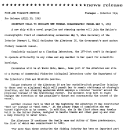A new ship with a novel propeller and steering system will join the Nation’s oceanographic fleet at commissioning ceremonies May 9, when Secretary of the Interior Steward L. Udall dedicates the Albatross IV, the Government’s most modern fishery research vessel.
Completely equipped as a floating laboratory, the 187-foot craft is designed to operate efficiently in any climate and any weather in her quest for scientific knowledge
Ceremonies will be at Woods Hole, Mass, home port of the Albatross and site of a Bureau of Commercial Fisheries biological laboratory under the Department of the Interior’s Fish and Wildlife Service.
Unique features of the Albatross IV are her variable-pitch propeller (similar to those used on airplanes) which will permit her to remain stationary at strategic locations, and her steering mechanism which employs a circular “nozzle” around the propeller instead of the traditional rudder. Its movement from left to right changes the direction of the propeller’s thrust and consequently the course of the vessel.
Another unusual fact is that the beginning of the Albatross IV was constructed “keel up” instead of “keel down”. At the proper state of completion she was turned right-side by cranes. In addition, she is the first stern ramp trawler built in the United States, designed to handle trawls and other gear up and down a ramp directly to water level.
The Albatross IV continues the family name and duties of three predecessors, the first of which was commissioned in 1882.
“For more than three centuries the fishing industry has been an important part of the history and economy of the New England area, the Department said. “Now with the dietary value of fishery products becoming more generally understood and with many nations of the world increasing efforts to harvest the resources of the oceans, we are working to improve our knowledge of the riches of the sea as well as our fishing techniques. Albatross IV, sturdy and versatile, will help speed our research projects.”
The Albatross IV is the largest and best equipped of the Department of the Interior’s oceanographic vessels. She is an all-season ship, designed for biological and oceanographic studies in any ocean. Her air-conditioned laboratories will enable her research to extend to the tropical waters of condition arise. The stern ramp for handling gear will permit operations in the roughest weather, the Department said. Her hull is especially braced against ice pressures for work in cold areas.
Twin diesel engines will drive the ship at 12 knots over a range of 9,000 miles.
Complete research facilities include wet and dry laboratories, photographic and electronic center, underwater television for studying the reaction of fish under natural conditions or within nets, underwater sonar, and an underwater electromagnetic log.
Quarters are provided for a crew of 22 and a scientific staff of 16.
Research will include charting the distribution and abundance of groundfish and scallops; environmental factors causing season and long-term fluctuation in fish stocks; collection of bottom organisms which form the food supply for groundfish and investigations of plankton populations and genera oceanographic conditions.
The ship was designed by Dwight S. Simpson & Associates of Boston, Mass., and was constructed by the Southern Shipbuilding Corporation of Slidell, La.
The original Albatross was decommissioned in 1921 after nearly 40 years o service as a fishery research vessel in both the Atlantic and Pacific Oceans, as naval auxiliary craft during the Spanish-American War and a patrol boat in the North Pacific. She was 234 feet long, 47 feet longer than the present Albatross. The Albatross II was converted Navy tug which saw fishery service from 19226 to 1932. The Albatross III was obtained from General Seafoods Corporation in 1939 for $1.
But like the first Albatross, she “went to war” and did not being her fishery research until 1948. She was deactivated in 1959.



